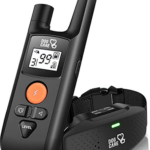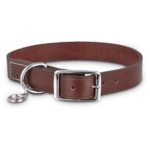Dog owners are often faced with a variety of challenges when it comes to training their furry companions. While positive reinforcement techniques can be highly effective, sometimes a more intensive approach is necessary. This is where dog care shock collars come into play.
In this guide, we will delve into the world of dog care shock collars and explore how they can help you train your pet more effectively. We’ll discuss the benefits of using a shock collar, how they work, and the different types available on the market. Additionally, we’ll provide tips for choosing the right collar for your dog and using it correctly in order to achieve optimal results.
Getting Started: What is a Dog Care Shock Collar
A dog care shock collar, also known as an electronic collar, e-collar, or remote collar, is a training tool designed to deliver an electric stimulus to a dog’s neck when triggered by the owner or trainer. This stimulus can be adjusted based on the situation and the individual dog’s needs.
Shock collars are often used in dog training as a form of punishment for unwanted behavior or as a means of teaching commands through positive reinforcement. While there has been some controversy surrounding their use, many trainers and owners argue that when used correctly, shock collars can be an effective tool for training dogs and improving their behavior.
 Why Choose a Shock Collar
Why Choose a Shock Collar
A dog care shock collar is one of the most effective tools for training your furry friend and ensuring that they are well-behaved. Shock collars offer a unique approach to training by delivering a harmless static shock or vibration that immediately interrupts unwanted behaviors, helping your dog to learn and understand what you expect from them.
Unlike traditional training methods, shock collars train dogs more quickly and effectively, making them an excellent choice for busy pet owners who do not have much time to spend on training. By using a high-quality shock collar and following proper usage guidelines, you can help your dog develop good habits and address problematic behaviors such as excessive barking, digging holes in the yard or jumping on people.
Dog Training with Shock Collars
Shock collars, also known as e-collars or training collars, are often used for dog training purposes. These collars are designed to deliver an electric shock to the dog’s neck when triggered by a remote control. The purpose of the shock is to get your dog’s attention and stop them from performing certain unwanted behaviors.
It is important to note that shock collars should not be used as a first resort when it comes to training your dog. They should only be used after other methods have failed, and under the guidance of a professional trainer. When used properly, they can be an effective way to train your dog and improve their behavior.
How Shock Collars Work for Dog Training
Using a shock collar for dog training can be a controversial topic, but when used properly and with the right level of intensity, it can be an effective tool to modify your dog’s behavior. The shock collar works by delivering an electric pulse to the dog’s neck when they exhibit unwanted behavior. This pulse is designed to get the dog’s attention and interrupt their current behavior. The intensity of the shock varies depending on the type of collar and level chosen.
The theory behind using a shock collar for training is that it provides an immediate consequence for undesired behavior, which can help your dog understand what you want them to do. For example, if your dog jumps up on people when greeting them, a quick pulse from the collar can signal that this behavior isn’t acceptable.
Types of Shock Collars
When it comes to choosing the right shock collar for your dog’s training, it is important to understand the different types that are available. The two main categories of shock collars are remote-controlled and bark-activated.
Remote-controlled collars allow dog owners to manually administer a shock to their dog through a handheld device. These collars come in various ranges, making them ideal for dogs that require long-range training, such as hunting or working dogs. On the other hand, bark-activated collars release a shock only when a dog barks excessively, making them an ideal option for dogs with excessive barking problems.
It is important to note that there are also static and vibration shock collars available on the market. Static collars deliver a small electrical current while vibration collars use vibrations instead of shocks to correct behavior. Additionally, there are also GPS trackers built into some remote-controlled shock collar models which can be very helpful in keeping track of your pet’s movements and keeping them safe.
 How to Choose the Right Shock Collar for Your Dog
How to Choose the Right Shock Collar for Your Dog
Choosing the right shock collar for your dog can be a daunting task, but with a little knowledge and research, you can make an informed decision. The first step in choosing the right shock collar is to determine the purpose of the collar. Is it for obedience training or correcting behavioral problems? Once you have determined this, you can then consider other important factors such as collar type, size, and features.
When selecting a shock collar for your dog, it is important to choose one that fits properly. A collar that is too loose can result in inconsistent shocks and may not effectively train your pup. On the other hand, a collar that is too tight can be harmful to your dog’s neck and cause discomfort. Additionally, consider features such as range and intensity levels. Range is important if you plan on using the collar at long distances while intensity levels should match your dog’s temperament.
Understanding Your Dog’s Temperament
Before choosing a shock collar for your dog, it is important to understand their temperament. Every dog is unique, and what works for one may not work for another. Some dogs are naturally more sensitive and may only require low levels of shock to respond to training, while others may require higher levels. Understanding your dog’s temperament can help you choose the right type of shock collar and also prevent any unnecessary harm to your furry friend.
If you have a timid or fearful dog, using a shock collar with high intensity can cause adverse effects such as increased anxiety or aggression towards people or other animals. On the other hand, if you have an independent and stubborn dog breed like Siberian Huskies or Great Danes, they may require a stronger stimulus to get their attention during training sessions.
To determine your dog’s temperament, it is advisable to consult with an animal behaviorist who can evaluate them and offer professional advice on choosing the most appropriate shock collar. Taking this step will ensure that you get the best results while keeping your pet safe during training sessions.
Correct Way to Introduce Shock Collars to Your Dog
Introducing a shock collar to your dog can be overwhelming for both you and your furry friend. Therefore, it’s essential to introduce it correctly. First, ensure that you have read the instruction manual carefully before you start using the collar. The manual will guide you on how to set up the collar and how to use it properly.
Once you have set up the collar, allow your dog to sniff and inspect it as they please without turning on the shock feature. This way, they’ll feel more comfortable wearing it. Next, put the collar on your dog for a few minutes each day and gradually increase the duration over several days. During this time, make sure that there are no distractions around so that your dog can concentrate on getting used to wearing it.
It’s also important not to use any commands or corrections until your dog is comfortable wearing the collar. Once they are used to having it on for extended periods without any issues, start using basic commands with low-level stimulation until they respond accordingly. Patience is key when introducing a shock collar; don’t rush things and take things slowly.
 Tips for Using a Shock Collar for Training
Tips for Using a Shock Collar for Training
Using a shock collar for dog training can be a controversial topic among pet owners. However, if used correctly, it can be an effective tool to help train your dog. Here are some tips to ensure that you are using the shock collar in the most humane and effective way:
Firstly, always use the lowest intensity setting that is effective for your dog. It is important not to use a high setting as it can cause pain and fear in your pet. Additionally, never use the shock collar as punishment or out of anger. It should only be used as part of a positive reinforcement training program.
Secondly, never leave the shock collar on your dog for extended periods of time. It should only be worn during training sessions and removed afterwards. Also, monitor your dog’s behavior during and after using the collar to gauge their reaction.
Lastly, try to avoid using the shock collar on small or young dogs as they may not have developed enough physically or emotionally to handle its use effectively.
Common Training Problems and Solutions
While shock collars can be highly effective in training dogs, they are not a silver bullet. It’s important to understand that poor use of shock collars can cause more harm than good. Some common problems that dog owners face when using shock collars include:
1. Over-reliance on Shock Collars
A major pitfall when using a shock collar is over-reliance on the device. Some people may feel that the collar is the only way to get their dog to behave, which can lead to neglecting other forms of positive reinforcement such as treats or verbal praise. This over-reliance on shock collars can cause your dog to become fearful and anxious instead of obedient.
2. Improper Timing and Intensity of Shocks
The timing and intensity of shocks must be carefully considered during training sessions. If the intensity is too high or shocks are delivered at inappropriate times, they could traumatize your pet causing them even more behavioral issues than before.
Solutions
To avoid these problems, it’s vital that dog owners choose a reliable and high-quality shock collar with customizable settings for intensity levels and vibration modes. Moreover, it’s essential to follow the instructions provided in the manual while using a shock collar on your dog.
A better approach for incorporating a shock collar into your dog’s training regime would be to use it as one tool among many others like verbal cues or hand signals for better communication with your pet. Using Positive Reinforcement techniques like treats for good behavior rather than relying solely on negative reinforcement is also
Conclusion
In conclusion, choosing the right shock collar for your dog can be a challenging decision. However, with proper research and understanding of your dog’s temperament, you can select the right shock collar that will aid in training and improve your dog’s behavior. Always remember to use the shock collar correctly and introduce it to your furry friend slowly. With patience and consistency, you can achieve a well-behaved and happy canine companion.








